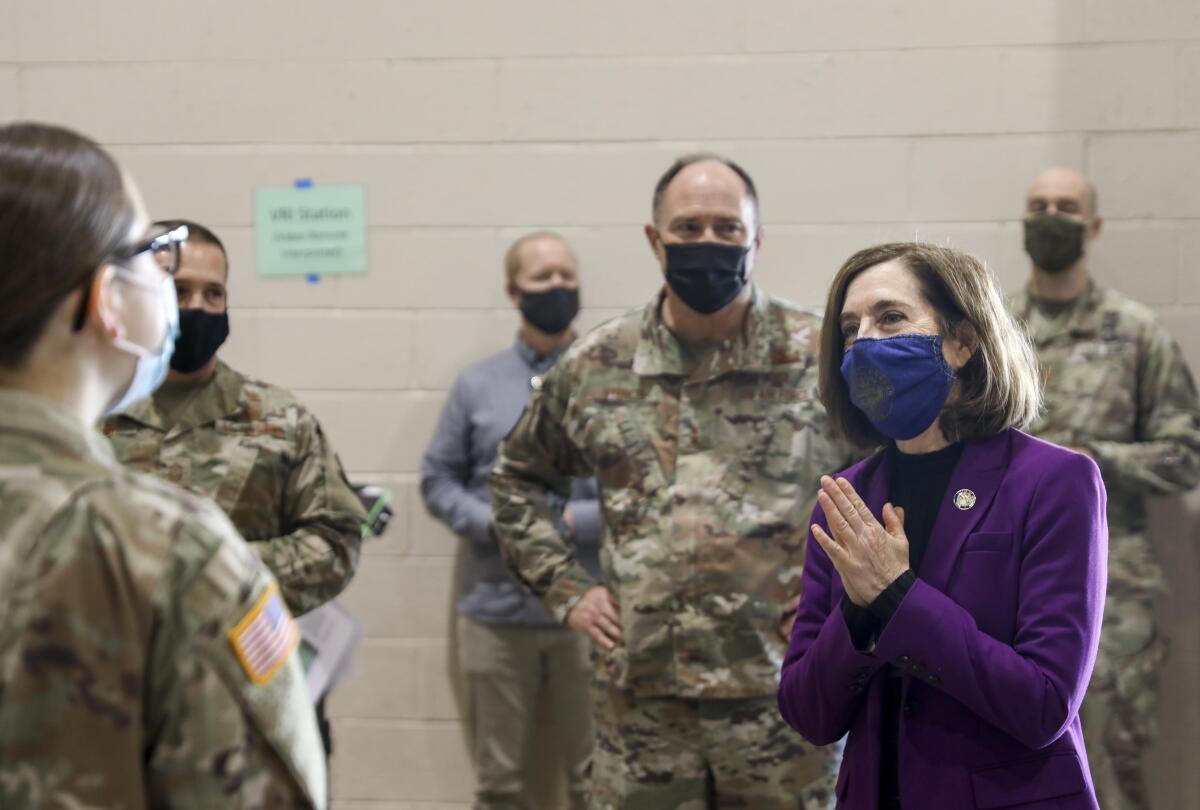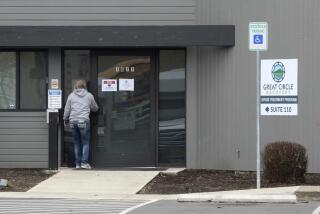COVID-19 surges in Oregon, sickening younger adults and forcing a return to restrictions

- Share via
LEBANON, Ore. — For months, Susannah Sbragia waited her turn for a COVID-19 vaccination while Oregon’s teachers, older adults and others with higher priority got theirs.
The 55-year-old city finance director was meticulous about wearing a mask and washing her hands during the pandemic. She worked at home and stayed fit with daily walks and YouTube dance lessons with her husband.
But a week before her appointment for an April 22 shot, she felt exhausted and began aching all over. A test confirmed COVID-19. She gasped for breath during an ambulance ride to Samaritan Lebanon Community Hospital, a 25-bed medical center in a onetime logging and lumber mill town 80 miles south of Portland.
Sbragia became one of hundreds of patients hospitalized in a COVID-19 surge that has struck Oregon, alarming officials, who have slammed the state’s opening measures into reverse. Doctors say that patients they’re seeing are younger, sicker and often without underlying medical conditions, suggesting that potent variants could be partly to blame.
On Friday, Gov. Kate Brown placed 15 counties in an “extreme risk” category, banning indoor dining at restaurants and limiting the number of patrons at gyms. She said the return to restrictions could save hundreds of lives and prevent as many as 450 hospitalizations over the next three weeks.
“What I can’t do is bring back someone’s life lost to this virus,” Brown said at a news conference Friday. “That’s why, as hard as this is, we must act immediately. This is truly a race between the variants and the vaccines.”
She imposed the restrictions after cases rose by 51% in two weeks, the fastest increase in the nation, and hospitalizations jumped by more than a third. As cases declined in much of the rest of the country, Oregon lurched in the opposite direction.
The situation is far from dire. The state’s average number of daily cases over the past week stood at 19 per 100,000 people — half of what they were during the state’s peak late last year and midrange nationally. In Michigan, where a record number of children have been hospitalized, the average daily case count is now 45 per 100,000.
But the worry is that the situation in Oregon could quickly spiral.
Officials were especially concerned that more than 300 people remained hospitalized with COVID-19 in a state with relatively few beds to spare.
Causes of the surge in Oregon — a state that had the third lowest cumulative case rate in the country, and the fourth lowest death rate — are something of mystery. Experts are trying to determine what factors are unique to the state.
The B.1.1.7 variant, first identified in the United Kingdom, accounts for more than half of Oregon’s recent cases. Hearing the circumstances of Sbragia’s infection, Chunhuei Chi, director of Oregon State University’s Center for Global Health, said in an interview that she may well have that variant, given its highly contagious nature.
Bundy, best known for leading the 2016 armed occupation of the Malheur National Wildlife Refuge, has launched a militia network that he describes as ‘neighborhood watch on steroids.’ Experts say it has strong overlap with right-wing extremist groups.
But he noted that B.1.1.7 is widespread, as the coronavirus sloshes around the globe. Instead, he said, seeds of Oregon’s surge may have been sown months ago, when the state got a slow start on vaccinations.
“I suspect that might have contributed,” he said. “We are looking at multiple factors contributing to this surge, including variants and people relaxing their guard because of pandemic fatigue and a sense of security or hope from vaccinations.”
In another anomaly that Chi said could be partly to blame, Brown moved school teachers ahead of citizens 65 and older for vaccines in January. She said she made the switch to speed school openings, but critics saw it as evidence of her fealty to the teachers union.
Dr. Dean Sidelinger, Oregon’s state epidemiologist, said Brown’s success with restrictions could help explain the surge. Keeping case numbers low left the state with a larger population lacking natural immunities from contracting COVID-19, he said.
“The success we’ve had in preventing illness and severe disease means we have to make up for that in vaccination, and that takes some time,” he said.
But Chi and Dr. Katie Sharff, an infectious disease specialist at Kaiser Permanente in Portland, were skeptical. “I think this is a small part of the reason that cases are spiking in Oregon,” Sharff said.
She pointed out that the Upper Midwest, including Michigan and Minnesota, have had prior surges and yet they are seeing another significant wave. Vermont, Maine and Hawaii have had low infection rates throughout the pandemic, and yet their case rates continue to decline, she noted.
Sharff noted that frail, elderly people are largely staying healthy during Oregon’s current surge, indicating that the vaccines have been effective. “Unfortunately there is a fraction of the population that either didn’t have access to the vaccine or chose not to get vaccinated, and that’s who we’re seeing at our hospitals,” she said.
She feels that the surge stems partly from authorities lifting some restrictions too quickly. Allowing wrestling and other indoor youth contact sports to resume was premature, she said.
But business owners have pushed for reopening, and the Oregon Restaurant & Lodging Assn. opposes Brown’s new restrictions. “It’s an incredible setback for thousands of businesses in our industry,” said Jason Brandt, association president and chief executive.
Lebanon, a town of 17,000 in the foothills of the Cascade Range, was the site of some of Oregon’s first coronavirus infections in March of last year, a week before Brown issued a statewide stay-at-home order. The disease killed eight residents of a veterans’ long-term care facility near the hospital.
The hospital, which serves a population with high rates of diabetes, lung disease, drug abuse and mental health conditions, admitted its first COVID-19 patient on June 18. Initially, staff members felt they had little to offer other than oxygen and supportive care, said Dr. Bill Barish, the hospital medical director.
“We’re used to doing things and helping people, rather than just watching them circling the drain,” he said.
But the staff was resourceful, Barish said, describing a team of five that scrambled in the intensive care unit early in the pandemic to pump air into the lungs of a COVID-19 patient in his 60s whom they had intubated. “It was like trying to ventilate concrete,” said Barish, who watched the man’s oxygen levels drop shortly after telling his family that he was recovering.
Schyler Sprague, a young respiratory therapist, ran to her office and returned with a “PEEP,” a valve that boosts airway pressure to the lungs.
“She saved his life,” he said.
The hospital’s highest COVID-19 admissions came in summer, with five or six inpatients at a time, a couple of months before state case numbers peaked. Admissions have been comparable during the current surge.
Sbragia, who was released from the hospital on Friday, falls into the age group between 50 and 64 that has seen the largest increase in hospitalizations statewide during the surge.
About 150 demonstrators march in Portland and smash windows; police report multiple arrests.
“You’re seeing a decrease in how seniors are being impacted,” because many of them have been vaccinated, Sidelinger said. “But we’ve also seen an increase in the youngest adults, in the 18 to 34 age group.”
In Portland, for example, a previously healthy woman in her 30s was admitted to a hospital this week with severe COVID-19 illness after being infected by her child.
In the central Oregon city of Bend, St. Charles Medical Center has exceeded 90% of its capacity in the surge. But Blue Mountain Hospital in Grant County, which had the third highest case rate in the country this week, has not been busy as people manage to recover at home.
Oregon has little margin for error, being the state with the fewest hospital beds per capita. In good times, the ratio is considered a plus, indicating efficient use of resources.
Now the race is on across the state to vaccinate as many people as possible, in hopes of making the current surge the state’s last. But the drive is meeting resistance, especially in rural areas, and counties with the lowest vaccination rates have the least demand for vaccines.
At the Lebanon hospital, doctors and administrators have championed vaccines. But not all staff members are interested. Two housekeepers who clean and disinfect rooms where COVID-19 patients are treated said they didn’t plan to get shots.
“I see people who get sick after getting vaccinated,” Barbara Strassman said.
“I feel we are born so healthy that there’s no reason to put things in our body like that,” Heather Atterberry said.
More to Read
Sign up for Essential California
The most important California stories and recommendations in your inbox every morning.
You may occasionally receive promotional content from the Los Angeles Times.













